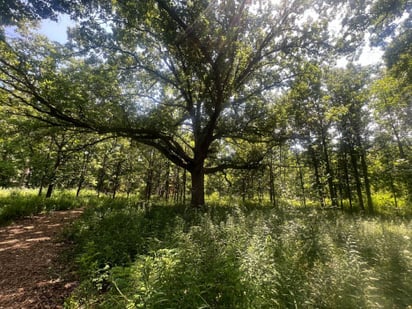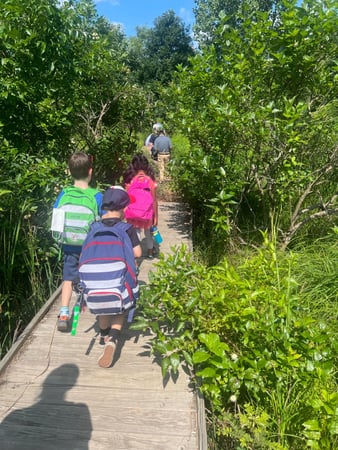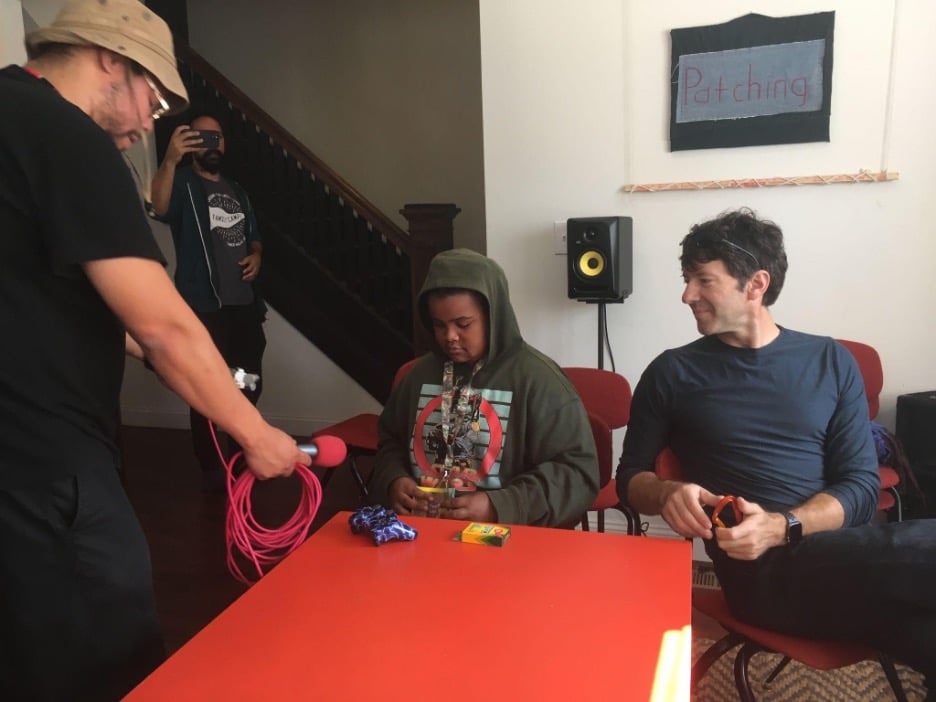TERC Blog
Sound Travels: Exploring the Unique Soundscape of North Park
In summer months, birds, bats, summer camp groups, and local families visit the North Park Village Nature Center grounds in Chicago. The Nature Center’s educators and director are curious about the sounds visitors create and experience during their visits to the Nature Center. Join Sound Travels researchers as they recount the ways they've begun a study of soundscape in this urban natural retreat.
This is part of an ongoing blog series that follows the Sound Travels researchers as they explore the visitor experience in science centers, nature centers, parks, and zoos across the country. Read about their journey in Columbus, Ohio here.
Greetings from Chicago
When you leave the busy streets of the North Park neighborhood, your eyes have to adjust. Instead of perceiving hard surfaces, parallel lines, geometric forms, and text in English and Spanish, your eyes take in natural forms, permeable surfaces, and shades of green.
 North Park Village Nature Center grounds
North Park Village Nature Center grounds
Photo by Justin R Meyers
The soundscape changes too, but not completely.
At this partner site, Sound Travels researcher Daniel Shanahan (Associate Professor of Music Cognition and Theory, Northwestern University) and project advisor Cesar Almeida (a youth leader and DJ with expertise in creating soundpacks based on cultural sound artifacts) walked the grounds with Nature Center staff and identified several spots to record sounds. Nature Center director Amaris Alanis Ribeiro and educator Lauren Podgorski were curious about which spots would pick up the loudest sounds and how the types of sounds would vary from place to place across the 40 acres.
Behind the Scenes with Audio Moths
Setting up the recorders and putting them in position took the better part of a day. This first time, Shanahan set the recorders at a low threshold, so even faint sounds would trigger a recording. After just a few days, the memory cards were full. The recorders had picked up 81,382 recordings of roughly 1-minute each from 7 different recorders taking 448 GB of space.

Example of an Audio Moth - Photo by Daniel Shanahan
Distinctive sounds include birds, planes, and a siren. Dan showed the Sound Travels team spectrographs from different sites, one way to visualize and compare the qualities of sound such as pitch, volume, and duration. This process also raises some practical questions: should we record all the time? Should we set cut-off points? What sounds should we focus on a priori, and how might we use this equipment to efficiently focus on these sounds?
Map and Notes of Sounds on June 8, 2023 at 10:17am
#1: Birdsong with truck reversing
#2: Group in the pollinator garden
#5: The same group in the distance, but not much truck
#6: Visitors walking
#7: Birdsong not as much noise from visitors
#9: We can hear the truck again from here, which is surprising
#11: Mixture of birdsong and traffic

A close up of the siren taken from audio moth #9 (referenced above)
The data revealed how intrusive sounds from trucks and sirens reached spaces well away from the park boundary. We also noticed the diversity of natural sounds, as well as the places where human voices blended with natural sounds. The polyphony of the nature center leads to interesting questions about what visitors focus on, what it means to be aware of one’s sonic environment, and what factors contribute to how one attends to their sonic space.
Beyond Metrics: The Personal Experience of Sound
These metrics of duration, intensity, and pitch won’t tell the full story of how visitors experience the soundscape. Sound is highly personal. Sounds that inspire some to dance drive others away. For that reason, TERC researcher Elise Levin-Güracar and researchers Joe E. Heimlich and Justin Reeves Meyer from COSI’s Center for Research and Evaluation (based in Columbus, Ohio), made their own visits, recording observations of a different kind.
Elise’s visit coincided with summer camp for preschoolers. She joined them for a sound walk through the wetlands. Students reported hearing frogs splash in the water, and their little feet crossing the boardwalk added to the soundscape. Elise also chatted informally with visitors as they left the Nature Center. One visiting parent with her daughter noted that the Nature Center provided a “nice little break from the city.” Young visitors noted that they heard the chirping of bugs, while many of the older visitors noted that they heard the roaring of planes taking off from the nearby airport.

Preschool children did an activity on the boardwalk to be super quiet and count on their hands how many different sounds they heard.
Photo by Elise Levin-Güracar
The Monarch Palooza
Justin and Joe visited on the weekend of the annual festival celebrating monarch butterflies and their migration. Educators and volunteers tell families the story of the lengthy journey monarchs take each fall and how the return takes even longer. This is a story that is very popular with environmental educators and monarch champions. In this neighborhood, the story has special resonance with many Mexican-Americans’ experience of leaving the mountainous state of Michoacán, where the monarchs overwinter in cloud forests. For many, their own stories of immigration mirror the butterflies’ search for a safe place to settle, come of age, and find nourishment for future journeys.
Visitor questions such as “Is this real?” filled the Nature Center building. Outdoors, instructors offered advice on using binoculars. At gathering spots like the picnic tables, birdsong was sometimes louder, sometimes fainter.
Future Explorations
In future visits, researchers will keep these experiences in mind as they survey and interview visitors, asking them about their expectations of sound, their impressions of sound, and the sounds they tolerate and enjoy in their daily lives.

Contributed by Martha Merson, Elise Levin-Güracar, and Daniel Shanahan











